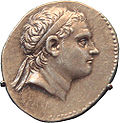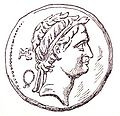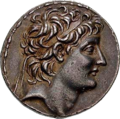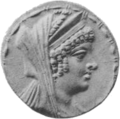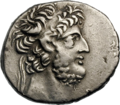Top Qs
Timeline
Chat
Perspective
Seleucid dynasty
Royal family of the Seleucid Empire From Wikipedia, the free encyclopedia
Remove ads
The Seleucid dynasty or the Seleucidae (/sɪˈluːsɪˌdiː/; Greek: Σελευκίδαι, Seleukídai, "descendants of Seleucus") was a Macedonian Greek royal family, which ruled the Seleucid Empire based in West Asia during the Hellenistic period. It was founded by Seleucus I Nicator, a general and successor of Alexander the Great, after the division of the Macedonian Empire as a result of the Wars of the Successors (Diadochi).
Remove ads
Through its history, the Seleucid dominion included large parts of the Near East, as well as of the Asian territory of the earlier Achaemenid Persian Empire. A major center of Hellenistic culture, it attracted a large number of immigrants from Greece who, encouraged by the Seleucids, formed a dominant political elite under the ruling dynasty.[1] After the death of Seleucus I, his successors maintained the empire's strength establishing it as a Greek power in West Asia;[2] the empire reached its height under emperor Antiochus III.[3] From the mid-second century BC, after its defeat at the hands of the resurgent Parthian Empire, the polity entered a state of instability with slow territorial losses and internecine civil wars. The Seleucids, now reduced to a rump state occupying a small part of Syria succumbed to the Rome's annexation of their territory in 64 BC under Pompey the Great.
Remove ads
History
Background
Seleucus (c. 358 – 281 BC) served as an officer of Alexander the Great, commanding the elite infantry corps in the Macedonian army: the "Shield-bearers" (Greek: Ὑπασπισταί, Hypaspistai), later known as the "Silvershields" (Ἀργυράσπιδες, Argyraspides).[4] After the death of Alexander in 323 BC, the Partition of Triparadisus assigned Seleucus as satrap of Babylon in 321 BC.[5] Antigonus, the satrap of much of Asia Minor, forced Seleucus to flee from Babylon, but, supported by Ptolemy, the Satrap of Egypt, Seleucus returned in 312 BC.[6] Seleucus' later conquests included Persia and Media. He agreed to a peace treaty with the Indian King Chandragupta Maurya (reigned 324-297 BC).[7] Seleucus defeated Antigonus in the Battle of Ipsus in 301 BC and Lysimachus (King of Thrace, Macedon and Asia Minor) in the battle of Corupedium (near Sardis) in 281 BC.[8][6] Ptolemy Ceraunus assassinated Seleucus later in the same year. Seleucus' eldest son Antiochus I succeeded him as ruler of the Seleucid territories in 281 BC.
Remove ads
Seleucid rulers
Remove ads
Family tree
Remove ads
See also
Footnotes
External links
Wikiwand - on
Seamless Wikipedia browsing. On steroids.
Remove ads







